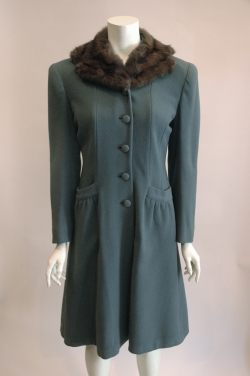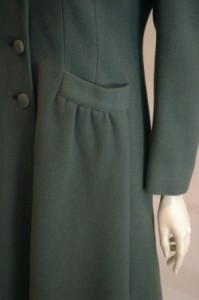Okay, I admit it. I am a label reader.
Nothing goes into my grocery cart without first reading the ingredient list and the nutrition information.
But I also read every fabric label when I’m clothes shopping, and, if you want to stretch your fabric dollar, you should too.
Think of it as the garment’s “nutrition label” that can clue you in to whether the fibers are natural or man-made, whether it’s real or faux fur, whether it will hold its shape after a few washings or be a sagging, pilled mess.
Of course, this can be a feat since not all vintage clothes have fabric labels. But fiber content labels are required by the Textile Fiber Products Identification Act of 1960. And the Wool Products Labeling Act of 1939, The Fur Products Labeling Act of 1951, and the Permanent Care Labeling Rule of 1972 also come into play.
Now I don’t foresee the FTC chasing down any vintage clothing dealers anytime soon because they sold a dress made by a tailor who failed to put in a fabric label.
I’m sure they’re quite busy bringing legal actions against bigger fish in the sea!
But I did speak with someone from the FTC this morning who confirmed (although this should not be construed as legal advice) that the federal laws do still apply to vintage clothing dealers and upcycled vintage designers.
If you’re a dealer, don’t panic just yet. Check with your state’s Consumer Protection Agency to see if any exceptions apply in your state.
If you’re a vintage clothing consumer, you probably shouldn’t expect full compliance with the law just yet and so the more you can learn about fabrics yourself the better.
Spend some time in a really great fabric shop and feel the difference between fabrics.
Why is this wool $49/yd and that one $9/yd? Can you feel the difference between the pure silk and the poly silk? Notice the difference between jerseys with different amounts of lycra.
After completing this exercise, you’ll really appreciate finding a fabulous quality textile like the wool in today’s VPOD.
This vintage 1940s coat has amazing lines and fantastic pockets. And to pump up the luxury quotient even more simply switch out the rabbit collar for one in mink, sable or fox.
It’s a fantastic forties find for a vintage fashionista!
Available at Olive’s Very Vintage. | More info on Textile Labeling Laws here.
(Sign up to receive the VPOD via email with detailed size, price and purchase information here. Your information will never be sold or shared and you can easily unsubscribe at any time.)











It’s a lovely coat, but for me the fur is a non-starter. Dark velvet would be nice instead.
So true about the fabric content labels. By knowing the fiber content you can also know how best to clean the item, which is vital to its durability.
I love the detail in the coat above where the pocket is cut from the same piece as the front panel, and then gathered. It’s hard to find such attention to detail in modern garments, and definitely not at the price point of vintage.